- Strategy Templates

Consulting Templates
- Market Analysis Templates

- Business Case

- Consulting Proposal

- Due Diligence Report
All Templates
How to write a solid business case (with examples and template).

Table of contents
What is a business case, business case vs. business plan, how to structure your business case, how to write a business case.
- Business Case PowerPoint template
ROI calculator template
- Key elements of a strong Business Case
Frequently asked questions
Nearly every new project requires approval—whether it's getting the green light from your team or securing support from executive stakeholders. While an informal email might suffice for smaller initiatives, significant business investments often require a well-crafted business case. This guide, written by former consultants from McKinsey and Bain, will help you write a compelling business case. It provides the steps and best practices to secure the necessary support and resources for a successful project.
A business case is a written document (often a PowerPoint presentation) that articulates the value of a specific business project or investment. It presents the rationale for the project, including the benefits, costs, risks, and impact. The main objective is to persuade internal stakeholders to endorse the project.
A business case answers the questions:
- Why should we do this?
- What is the best solution?
- What will happen if we proceed with this investment decision?
Business cases can serve many purposes, but here are a few common reasons for developing one:
- Implementation of a new IT system
- Launching a new product line
- Construction of a new manufacturing plant or data center
- Opening new retail locations or expanding into international markets
- Implementation of new compliance and risk management systems
- Acquiring a competitor or a complementary business
- Investing in building a new capability
- Obtaining additional resources for an ongoing initiative
- Deciding whether to outsource a function
Simply put, a business case justifies a specific project or initiative, while a business plan outlines an entire business's overall strategy, goals, and detailed planning.
Investors use a business plan to make informed decisions about investing. It details the financial, strategic, and operational aspects of a business, helping investors assess the potential return on investment. In contrast, a business case is narrowly focused on a particular project or initiative. It helps stakeholders evaluate the potential impact of that specific project on the business. Both documents require thorough research, careful writing, and effective presentation. Here's an overview of their differences:
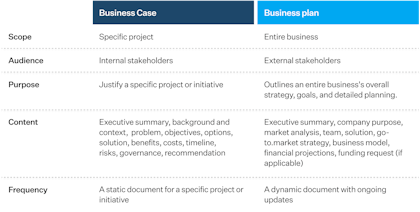
Before writing your business case
The fate of your project or initiative will usually lie with a small group of decision makers. The best way to increase your chances of getting a green light is to engage with stakeholders, gather their insights, and build support before writing the business case. Use their input to construct a rough draft and present this draft back to key stakeholders for feedback and approval. Only once you have understood their priorities and concerns should you proceed with writing the final business case.
To get buy-in from your stakeholders, you must tell your "story" so that it is easy to understand the need, the solution you're proposing, and the benefits to the company. Generally, decision-makers will care most about ROI and how your project aligns with the organization's strategic goals – so keep those issues front and center.
In our experience, the business case structure below is the most logical and effective, but you should generally use whatever format or template your company uses. If no templates exist, use the structure below and find a solid template (you'll find a link to a template later in this post).
Whatever structure or template you apply, remember that your story needs to be clear above all else.
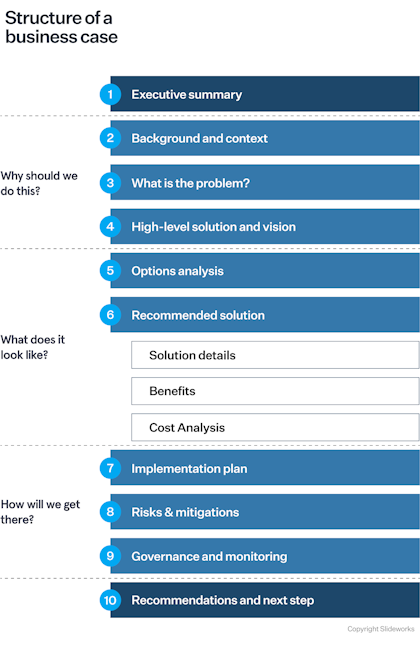
Let's go through each of the 10 sections one-by-one:
1. Executive Summary
A one-page summary providing a concise overview of the business case.
Highlight the key points, including the problem or opportunity, proposed solution, and expected benefits.
We recommend structuring your summary using the Situation-Complication-Solution framework (See How to Write an Effective Executive Summary ) . The executive summary should be the final thing you write.
2. Background and context
Start with the why. Outline the situation and the business problem or opportunity your business case addresses. Clearly describe the problem's impact on the organization.
This section may include an overview of the macro environment and dynamics, key trends driving change, and potential threats or opportunities. Share data that conveys urgency . For example: Is customer satisfaction dropping because of a lack of product features? Is an outdated IT system causing delays in the sales process? Are you seeing growing competition from digital-first players in the market? Are you seeing an opportunity as a result of changing customer needs?
3. What is the problem?
This is a key part of your business case. Your business case is built from your analysis of the problem. If your stakeholders don't understand and agree with your articulation of the problem, they'll take issue with everything else in your business case.
Describe the underlying issues and their solutions using data. You might include customer data, input from end users, or other information from those most affected by the problem.
4. High-level solution and vision
Start with a high-level description of the solution. Clarify the specific, measurable objectives that the project aims to achieve. Ensure these objectives align with the organization's strategic goals.
5. Option analysis
You have now answered the question: Why should we do this project? - and you have outlined a compelling solution.
In this section, you identify and evaluate different options for addressing the problem. Include a "do nothing" option as a baseline for comparison. Assess the pros and cons of each option, considering factors like cost, feasibility, risk, and potential benefits.
See a more in-depth article on how to think about and present risks in our blog post " Mastering Risk Mitigation Slides: A Best Practice Guide with Examples ".
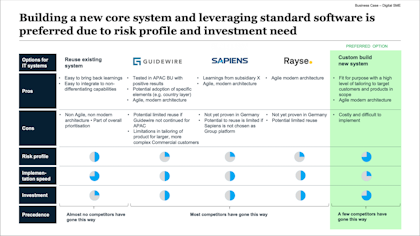
Slide summarizing various options for a new IT system. Example from Slideworks Business Case Template Slide
6. Recommended Solution
Solution Details Propose the preferred solution based on the options analysis. Describe the solution in detail, including scope, deliverables, and key components. Justify why this solution is the best choice.
Benefits Describe the benefits (e.g., cost savings, increased revenue, improved efficiency, competitive advantage). Include both tangible and intangible benefits, but focus on benefits you can quantify. Your stakeholders will want to know the financial impact.
Be very clear about where your numbers come from. Did you get them from colleagues in Marketing, Finance, HR, or Engineering? Stakeholders care about the sources for these assumptions and are more likely to trust your numbers if they come from (or are validated by) people they trust.
Cost Analysis In this section, you provide a detailed breakdown of the costs associated with the proposed solution. Include initial investment, ongoing operational costs, and any potential financial risks.
Compare the costs against the expected benefits to demonstrate return on investment (ROI).
7. Implementation plan
Outline a high-level plan for implementing the proposed solution . Include key milestones, timelines, and dependencies. Describe the resources required, including personnel, technology, and funding.
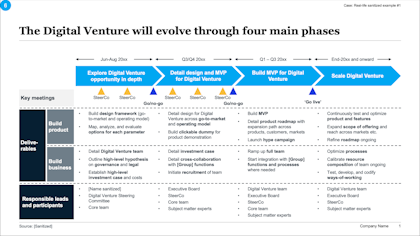
Roadmap example - New digital venture. Slideworks Business Case Template
8. Risks and mitigations
In this section, you highlight potential risks and uncertainties associated with the project. Try to focus on the most important risks (you don't need to account for every potential scenario). These typically include those affecting cost, benefits, and schedule, but they can also include risks to the team, technology, scope, and performance.
Be realistic when you write this section. Transparency will gain the confidence of stakeholders and will demonstrate your foresight and capability.
Consider ranking your identified risk areas according to "likelihood of risk" and "impact of risk" (as shown in the example below). Then, propose mitigation strategies to manage and minimize risks.
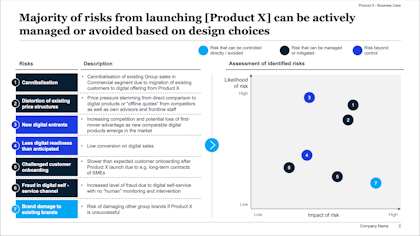
Example of Risks Slide - Slideworks Business Case Template
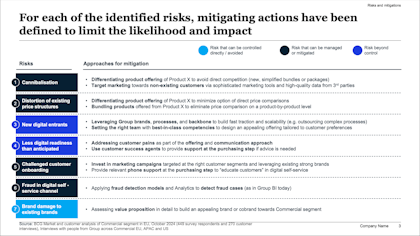
Risks and mitigation slide - Slideworks Business Case Template
9. Governance and monitoring
Establishing a clear governance structure ensures that there is a defined hierarchy of authority, responsibilities, and accountability. A definition of the following groups and roles are often included:
- Steering Committee : A group of senior executives or stakeholders who provide overall strategic direction, make high-level decisions, and ensure that the project aligns with organizational goals.
- Project Sponsor : An individual or group with the authority to provide resources, make critical decisions, and support the project at the highest level. The sponsor is often a senior executive.
- Project Manager : The person responsible for day-to-day management of the project, ensuring that the project stays on track, within budget, and meets its objectives. The project manager reports to the steering committee and project sponsor.
- Project Team : A group of individuals with various skills and expertise necessary to carry out project tasks. The team may include internal staff and external consultants.
You might also define what monitoring and reporting mechanisms that will be used to track the project's progress, identify issues early, and ensure accountability. These mechanisms often include specific Project Management Tools, ongoing status reports, and meetings.
10. Recommendations and next steps
In this last section, you summarize the key points of the business case and make a final recommendation to the decision-makers . Remember to Include your ROI number(s) again and repeat how your project aligns with the organization's strategic goals.
Consider ending your business case with a final slide outlining the immediate actions required to move forward with the recommended solution.
Learn about how to fit in a business case in your commercial due diligence report in our article here .
Business Case PowerPoint template
An effective business case requires both the right content and structure. A strong template and a few best practice examples can ensure the right structure and speed up the process of designing individual slides.
The Slideworks Business Case Template for PowerPoint follows the methodology presented in this post and includes 300 PowerPoint slides, 3 Excel models, and three full-length, real-life case examples created by ex-McKinsey & BCG consultants.
Often, companies have a preferred method of calculating a project's ROI. If this is not the case, you should use the one most appropriate to your project—break-even analysis, payback period, NPV, or IRR.
Key elements of a strong Business Case
Involve subject-matter experts To develop a comprehensive business case, draw on insights from experts who understand the problem's intricacies and potential solutions. Involve colleagues from relevant departments such as R&D, sales, marketing, and finance to ensure all perspectives are considered.
Involve key stakeholders Get input from all relevant team members, including HR, finance, sales, and IT. This collaborative approach ensures the business case is built on verified expert knowledge. Encouraging teamwork and buy-in from internal stakeholders helps build a strong foundation of support.
Understand audience objectives Align your business case with the company’s strategic objectives and future plans. Clearly demonstrate how the project supports long-term company success. Consider the competition for resources and justify the investment by showing its relevance and importance.
Set a clear vision Communicate the purpose, goals, methods, and people involved in the initiative clearly. Detail what the project aims to solve or achieve and its impact on the organization. This clarity helps stakeholders understand the overall vision and direction of the project.
Be on point Be concise and provide only the necessary information needed for informed decision-making. Base your details on facts collected from team members and experts, avoiding assumptions. This precision ensures your business case is credible and actionable.
Check out our Go-To-Market Strategy post to take the next step on bringing your business idea to life.
What is the difference between a project business case and a project charter?
A project charter and a business case are distinct but complementary documents. The business case is created first and serves to justify the project's initiation by detailing its benefits, costs, risks, and alignment with organizational goals. It is used by decision-makers to approve or reject the project.
Once the project is approved, a project charter is often developed to formally authorize the project, outlining its objectives, scope, key stakeholders, and the project manager's authority. A summary of the business case is often included in the project charter.
How long should a business case be?
A comprehensive business case doesn't have a specific page count but should be detailed enough to clearly communicate the project's benefits, costs, risks, and alignment with organizational goals. For small projects, it may be a few pages; for larger or complex projects, it typically ranges from 10-20 word pages (30-50 slides), excluding appendices. Sources: Harvard Business Press - Developing a Business Case
Download our most popular templates
High-end PowerPoint templates and toolkits created by ex-McKinsey, BCG, and Bain consultants

Create a full business case incl. strategy, roadmap, financials and more.

- Market Analysis
Create a full market analysis report to effectively turn your market research into strategic insights

- Market Entry Analysis
Create a best-practice, well-structured market study for evaluating and comparing multiple markets.
Related articles
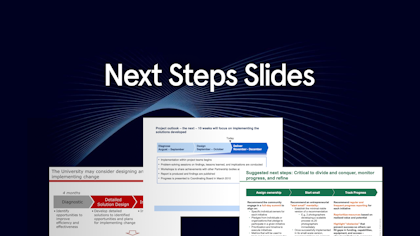
How to write a Next Steps slide (with Examples and Free Template)
In this blog post, we’ll dive into the Next Steps slide, why it’s important, and how to write one. We’ll also provide you with examples of Next Steps slides from McKinsey, BCG, and Bain, as well as a free template for you to create your own Next Steps slide.
Nov 1, 2024

Picking apart a McKinsey consulting proposal
In this blog post, we’ll break down a McKinsey consulting proposal, look at what works and why, and discuss how to write a winning consulting proposal.
Oct 12, 2024

20 PowerPoint shortcuts every consultant must know
We surveyed a group of top-tier consultants and identified their top PowerPoint shortcuts. This post explains how to use them efficiently.
Sep 23, 2024

- Consulting Toolkit
- Business Strategy
- Consulting Maps Bundle
- Mergers & Acquisitions
- Digital Transformation
- Product Strategy
- Go-To-Market Strategy
- Operational Excellence I
- Operational Excellence II
- Operational Excellence III
- Full Access Bundle
- Consulting PowerPoint Templates
- How it works
- Terms & Conditions
- Privacy Policy
© 2024 Slideworks. All rights reserved
Denmark : Farvergade 10 4. 1463 Copenhagen K
US : 101 Avenue of the Americas, 9th Floor 10013, New York

How to Write a Great Business Case
Explore more.
- Case Teaching
C ase studies are powerful teaching tools. “When you have a good case, and students who are well prepared to learn and to teach each other, you get some magical moments that students will never forget,” says James L. Heskett, UPS Foundation Professor of Business Logistics, emeritus, at Harvard Business School (HBS). “They will remember the lessons they learn in that class discussion and apply them 20 years later.”
Yet, for many educators who want to pen their own case, the act of writing a great business case seldom comes easily or naturally. For starters, it’s time consuming. Case writers can spend substantial time visiting companies, securing a willing site, conducting interviews, observing operations, collecting data, reviewing notes, writing the case, revising the narrative, ensuring that teaching points come through, and then getting executives to approve the finished product.
The question, then, becomes: Where do you begin? How do you approach case writing? How do you decide which company to use as the subject of the case? And what distinguishes a well-written case from a mediocre one?
We asked three expert HBS case writers—who collectively have written and supported hundreds of cases—to share their insights on how to write a great business case study that will inspire passionate classroom discussion and transmit key educational concepts.
Insights from James L. Heskett
UPS Foundation Professor of Business Logistics, Emeritus, Harvard Business School
Keep your eyes open for a great business issue.
“I’m always on the prowl for new case material. Whenever I’m reading or consulting, I look for interesting people doing interesting things and facing interesting challenges. For instance, I was reading a magazine and came across a story about how Shouldice Hospital treated patients undergoing surgery to fix inguinal hernias—how patients would get up from the operating table and walk away on the arm of the surgeon.
6 QUALITIES OF GREAT CASE WRITERS
Comfort with ambiguity, since cases may have more than one “right” answer
Command of the topic or subject at hand
Ability to relate to the case protagonists
Enthusiasm for the case teaching method
Capacity for finding the drama in a business situation and making it feel personal to students
Build relationships with executives.
“When writing a case, it’s helpful to start as high in the organization as possible. It helps assure mid-level managers that they can share the information you need with an outsider. It also helps when it comes to getting the case cleared for use. Serving on corporate boards can help in building relationships with senior executives, but there are other ways to make those connections. For instance, you can approach speakers at business conferences if you think their presentations could form the basis for a good business case. If you want to write about a company where you don’t have any personal connections, you can always check with your colleagues to see if any of them have a personal relationship with the CEO or sit on a board where they could introduce you to the right person who would be able to facilitate the case. My colleagues and I make a lot of these introductions for each other.”
“If you make the case into a crossword puzzle that takes five hours to solve, it’s not really fair to the students and will most likely cause them to lose focus.” James L. Heskett
Skip the curveballs and focus on key issues.
“Cases don’t have to be obvious. As a pedagogical objective, you might want students to look beyond a superficial issue to say this is the underlying topic that we need to address, and these are the questions we need to pose. Still, I think it’s unhelpful if cases contain real curveballs where ‘unlocking’ the case depends on finding some small piece of information hidden in an exhibit. Give students a break! They may have to read and digest three cases per day, so they probably won’t be able to devote more than a couple of hours to each one. If you make the case into a crossword puzzle that takes five hours to solve, it’s not really fair to the students and will most likely cause them to lose focus.”
Build a discussion plan while writing the case.
“In case method teaching, the teacher is not in complete control. Students teach each other and learn from each other. On any given day, there will likely be somebody in the room who knows more about the company featured in the case than the professor does. So a professor can’t walk into the classroom and expect to impose a lesson plan that goes in a strict linear way from A to B to C to D. The case ought to be written to allow students to jump from A to D and then come back later to B if that’s how the discussion plays out. At the same time, the case should be structured so that the instructor can collect student comments on a board, organizing them as a coherent set of related ideas, and then deliver a 5-to-10-minute summary that communicates whatever essential concepts the case has covered. This summation can be a very powerful teaching and learning experience.”
Focus on quality over quantity.
“Cases don’t have to be too long. Some good cases are only two or three pages. Students may give more scrutiny to these brief cases than they would a 20-page case.”
Advice from Benson P. Shapiro
Malcolm P. McNair Professor of Marketing, Emeritus, Harvard Business School
Take out the chaff in advance.
“You don’t want students to spend too much time separating the wheat from the chaff. If a case has 12 pages of text and 10 pages of exhibits, even the smartest MBA students will likely lose interest. Writers who try to capture a situation from every angle and in every detail end up with sprawling narratives that usually do not make a good case. When writing cases, you need to set good, strong boundaries. Avoid superfluous, flowery, or poetic material that may contain interesting anecdotes or factoids, but that could distract readers from the case’s core topics. Include only those important and useful details that can help students make decisions and understand key issues that the case explores.”
Work in layers and metaphors—subtly.
“The best cases work on multiple levels. A case should focus on a specific situation—for example, whether or not to introduce a certain product. But it should also serve as a metaphor for broader issues in the background: How do we think about introducing new products? Are we introducing enough products? Are new product introductions a source of competitive advantage in our industry? How should we organize and manage new product development? You want the case to encourage students to think broadly about the various cultural, financial, and strategic impacts that managerial decisions have on a company.”
“Writers who try to capture a situation from every angle and in every detail end up with sprawling narratives that usually do not make a good case.” Benson P. Shapiro
Encourage emotional engagement.
“Case writing is an interesting literary form—it needs to be very engaging, but also educational. Great cases revolve around points of contention on which intelligent people can hold different points of view: What should you do? Why? How do you get it done? Ideally, students should have to choose between two very attractive alternatives or two terrible alternatives. The best cases involve questions that get students emotionally engaged so that they really care about choices and outcomes. When you see students physically leaning forward and following what their peers are saying, you know that they have a visceral feel for the importance of the subject. When you hear them debating after class— You were out in left field! You missed what was really important here! —that’s how you can tell you succeeded in developing a great case.”
Lessons from Carin-Isabel Knoop
Executive Director of the Case Research & Writing Group, Harvard Business School
Don’t forget the classroom component.
“Cases are deliberately incomplete documents. What a case writer leaves out of a case is often just as important as what he or she puts into it. Cases are designed to be completed through classroom instruction and discussion. While drafting the case, try to develop the classroom process in parallel. Work on the assignment questions and classroom content. Keep in mind that the case should be able to adapt to your classroom and course needs.”
Hone your elevator pitch.
“Before getting started, always have clear, succinct learning objectives in mind. Don’t start developing the case until you are able to summarize these objectives in less than five minutes.”
Case writing is a relationship, not a transaction.
When choosing a case site, be clear with executives that you are developing a teaching tool and that you will require their time and candor—and eventually their data. Put them at ease, and manage the authorization process, right from the start. Indicate that quotes will be cleared before publication and there will be time for individual review. During the creation process, ask their advice. This creates a process of engagement and helps bring home that this is a pedagogical tool, not gotcha journalism. At HBS, we oftentimes invite someone from the company to attend class. Finally, once the case is done, stay in touch with your case protagonists. They will move to other organizations and spread the good word about their experience with case writing.
Invite disagreement in case discussions.
“The case study method is based on participant-centered learning. The students all start from the same base of 11 (or however many) pages in the case, but they bring different knowledge and experiences into the classroom. So they can take the same facts and disagree about what course of action to pursue. We want students to behave like decision makers, and it can be painful to make decisions. Some critics deride the case teaching method as being unrealistic, but someone who just lectures about marketing doesn’t help students realize how difficult it is to choose between two plausible options to meet the same marketing objectives. For students, a big part of the education process is learning from discussions with classmates who think differently and advocate for different solutions. Witnessing a robust case discussion reminds us of the potential for collective learning to emerge from contrasting views.”
“Faculty don’t just write cases for teaching purposes, they write them to learn.” Carin-Isabel Knoop
The Case Writing Process Is a Worthy Effort
Researching, writing, and publishing cases is well worth the time and effort. “The case research and writing process is important for faculty development,” Knoop adds. “While developing field cases, faculty go to site visits and meet with decision makers. The case writing process helps connect scholars to practitioners and practitioners to the academic world. Faculty case writers get to explore and test how their academic theories work in practice. So faculty don’t just write cases for teaching purposes, they write them to learn. The case method is an integral part of faculty development.”
There’s another big bonus to becoming a case writer, especially for younger educators. “Young business instructors face a credibility gap with their students,” says Heskett. “It’s not uncommon to have MBA students in a class who have more experience than the instructor on a particular subject. Once you go into the field and write a case, you will know more about that subject than anyone else in the class. A primary way for professors to establish their credibility on a topic is to have written the case the class is discussing that day.”

James L. Heskett is UPS Foundation Professor of Business Logistics, emeritus, at Harvard Business School. He completed his Ph.D. at the Graduate School of Business, Stanford University, and has been a faculty member at The Ohio State University as well as president of Logistics Systems, Inc. Since 2000, he has authored a blog on Harvard Business School’s Working Knowledge website .

Benson P. Shapiro is the Malcolm P. McNair Professor of Marketing, emeritus, at Harvard Business School where he taught full time from 1970 to 1997. Since 1997, Shapiro has concentrated his professional time on consulting, giving speeches, serving on boards, and writing. He continues to teach at Harvard and has taught in many executive programs and has chaired the Sustainable Marketing Leadership for Mid-Sized Firms Program.

Carin-Isabel Knoop is the executive director of the Case Research & Writing Group at Harvard Business School. She is also coauthor of Compassionate Management of Mental Health in the Modern Workplace .
Related Articles
We use cookies to understand how you use our site and to improve your experience, including personalizing content. Learn More . By continuing to use our site, you accept our use of cookies and revised Privacy Policy .
How to write a case study — examples, templates, and tools

It’s a marketer’s job to communicate the effectiveness of a product or service to potential and current customers to convince them to buy and keep business moving. One of the best methods for doing this is to share success stories that are relatable to prospects and customers based on their pain points, experiences, and overall needs.
That’s where case studies come in. Case studies are an essential part of a content marketing plan. These in-depth stories of customer experiences are some of the most effective at demonstrating the value of a product or service. Yet many marketers don’t use them, whether because of their regimented formats or the process of customer involvement and approval.
A case study is a powerful tool for showcasing your hard work and the success your customer achieved. But writing a great case study can be difficult if you’ve never done it before or if it’s been a while. This guide will show you how to write an effective case study and provide real-world examples and templates that will keep readers engaged and support your business.
In this article, you’ll learn:
What is a case study?
How to write a case study, case study templates, case study examples, case study tools.
A case study is the detailed story of a customer’s experience with a product or service that demonstrates their success and often includes measurable outcomes. Case studies are used in a range of fields and for various reasons, from business to academic research. They’re especially impactful in marketing as brands work to convince and convert consumers with relatable, real-world stories of actual customer experiences.
The best case studies tell the story of a customer’s success, including the steps they took, the results they achieved, and the support they received from a brand along the way. To write a great case study, you need to:
- Celebrate the customer and make them — not a product or service — the star of the story.
- Craft the story with specific audiences or target segments in mind so that the story of one customer will be viewed as relatable and actionable for another customer.
- Write copy that is easy to read and engaging so that readers will gain the insights and messages intended.
- Follow a standardized format that includes all of the essentials a potential customer would find interesting and useful.
- Support all of the claims for success made in the story with data in the forms of hard numbers and customer statements.
Case studies are a type of review but more in depth, aiming to show — rather than just tell — the positive experiences that customers have with a brand. Notably, 89% of consumers read reviews before deciding to buy, and 79% view case study content as part of their purchasing process. When it comes to B2B sales, 52% of buyers rank case studies as an important part of their evaluation process.
Telling a brand story through the experience of a tried-and-true customer matters. The story is relatable to potential new customers as they imagine themselves in the shoes of the company or individual featured in the case study. Showcasing previous customers can help new ones see themselves engaging with your brand in the ways that are most meaningful to them.
Besides sharing the perspective of another customer, case studies stand out from other content marketing forms because they are based on evidence. Whether pulling from client testimonials or data-driven results, case studies tend to have more impact on new business because the story contains information that is both objective (data) and subjective (customer experience) — and the brand doesn’t sound too self-promotional.

Case studies are unique in that there’s a fairly standardized format for telling a customer’s story. But that doesn’t mean there isn’t room for creativity. It’s all about making sure that teams are clear on the goals for the case study — along with strategies for supporting content and channels — and understanding how the story fits within the framework of the company’s overall marketing goals.
Here are the basic steps to writing a good case study.
1. Identify your goal
Start by defining exactly who your case study will be designed to help. Case studies are about specific instances where a company works with a customer to achieve a goal. Identify which customers are likely to have these goals, as well as other needs the story should cover to appeal to them.
The answer is often found in one of the buyer personas that have been constructed as part of your larger marketing strategy. This can include anything from new leads generated by the marketing team to long-term customers that are being pressed for cross-sell opportunities. In all of these cases, demonstrating value through a relatable customer success story can be part of the solution to conversion.
2. Choose your client or subject
Who you highlight matters. Case studies tie brands together that might otherwise not cross paths. A writer will want to ensure that the highlighted customer aligns with their own company’s brand identity and offerings. Look for a customer with positive name recognition who has had great success with a product or service and is willing to be an advocate.
The client should also match up with the identified target audience. Whichever company or individual is selected should be a reflection of other potential customers who can see themselves in similar circumstances, having the same problems and possible solutions.
Some of the most compelling case studies feature customers who:
- Switch from one product or service to another while naming competitors that missed the mark.
- Experience measurable results that are relatable to others in a specific industry.
- Represent well-known brands and recognizable names that are likely to compel action.
- Advocate for a product or service as a champion and are well-versed in its advantages.
Whoever or whatever customer is selected, marketers must ensure they have the permission of the company involved before getting started. Some brands have strict review and approval procedures for any official marketing or promotional materials that include their name. Acquiring those approvals in advance will prevent any miscommunication or wasted effort if there is an issue with their legal or compliance teams.
3. Conduct research and compile data
Substantiating the claims made in a case study — either by the marketing team or customers themselves — adds validity to the story. To do this, include data and feedback from the client that defines what success looks like. This can be anything from demonstrating return on investment (ROI) to a specific metric the customer was striving to improve. Case studies should prove how an outcome was achieved and show tangible results that indicate to the customer that your solution is the right one.
This step could also include customer interviews. Make sure that the people being interviewed are key stakeholders in the purchase decision or deployment and use of the product or service that is being highlighted. Content writers should work off a set list of questions prepared in advance. It can be helpful to share these with the interviewees beforehand so they have time to consider and craft their responses. One of the best interview tactics to keep in mind is to ask questions where yes and no are not natural answers. This way, your subject will provide more open-ended responses that produce more meaningful content.
4. Choose the right format
There are a number of different ways to format a case study. Depending on what you hope to achieve, one style will be better than another. However, there are some common elements to include, such as:
- An engaging headline
- A subject and customer introduction
- The unique challenge or challenges the customer faced
- The solution the customer used to solve the problem
- The results achieved
- Data and statistics to back up claims of success
- A strong call to action (CTA) to engage with the vendor
It’s also important to note that while case studies are traditionally written as stories, they don’t have to be in a written format. Some companies choose to get more creative with their case studies and produce multimedia content, depending on their audience and objectives. Case study formats can include traditional print stories, interactive web or social content, data-heavy infographics, professionally shot videos, podcasts, and more.
5. Write your case study
We’ll go into more detail later about how exactly to write a case study, including templates and examples. Generally speaking, though, there are a few things to keep in mind when writing your case study.
- Be clear and concise. Readers want to get to the point of the story quickly and easily, and they’ll be looking to see themselves reflected in the story right from the start.
- Provide a big picture. Always make sure to explain who the client is, their goals, and how they achieved success in a short introduction to engage the reader.
- Construct a clear narrative. Stick to the story from the perspective of the customer and what they needed to solve instead of just listing product features or benefits.
- Leverage graphics. Incorporating infographics, charts, and sidebars can be a more engaging and eye-catching way to share key statistics and data in readable ways.
- Offer the right amount of detail. Most case studies are one or two pages with clear sections that a reader can skim to find the information most important to them.
- Include data to support claims. Show real results — both facts and figures and customer quotes — to demonstrate credibility and prove the solution works.
6. Promote your story
Marketers have a number of options for distribution of a freshly minted case study. Many brands choose to publish case studies on their website and post them on social media. This can help support SEO and organic content strategies while also boosting company credibility and trust as visitors see that other businesses have used the product or service.
Marketers are always looking for quality content they can use for lead generation. Consider offering a case study as gated content behind a form on a landing page or as an offer in an email message. One great way to do this is to summarize the content and tease the full story available for download after the user takes an action.
Sales teams can also leverage case studies, so be sure they are aware that the assets exist once they’re published. Especially when it comes to larger B2B sales, companies often ask for examples of similar customer challenges that have been solved.
Now that you’ve learned a bit about case studies and what they should include, you may be wondering how to start creating great customer story content. Here are a couple of templates you can use to structure your case study.
Template 1 — Challenge-solution-result format
- Start with an engaging title. This should be fewer than 70 characters long for SEO best practices. One of the best ways to approach the title is to include the customer’s name and a hint at the challenge they overcame in the end.
- Create an introduction. Lead with an explanation as to who the customer is, the need they had, and the opportunity they found with a specific product or solution. Writers can also suggest the success the customer experienced with the solution they chose.
- Present the challenge. This should be several paragraphs long and explain the problem the customer faced and the issues they were trying to solve. Details should tie into the company’s products and services naturally. This section needs to be the most relatable to the reader so they can picture themselves in a similar situation.
- Share the solution. Explain which product or service offered was the ideal fit for the customer and why. Feel free to delve into their experience setting up, purchasing, and onboarding the solution.
- Explain the results. Demonstrate the impact of the solution they chose by backing up their positive experience with data. Fill in with customer quotes and tangible, measurable results that show the effect of their choice.
- Ask for action. Include a CTA at the end of the case study that invites readers to reach out for more information, try a demo, or learn more — to nurture them further in the marketing pipeline. What you ask of the reader should tie directly into the goals that were established for the case study in the first place.
Template 2 — Data-driven format
- Start with an engaging title. Be sure to include a statistic or data point in the first 70 characters. Again, it’s best to include the customer’s name as part of the title.
- Create an overview. Share the customer’s background and a short version of the challenge they faced. Present the reason a particular product or service was chosen, and feel free to include quotes from the customer about their selection process.
- Present data point 1. Isolate the first metric that the customer used to define success and explain how the product or solution helped to achieve this goal. Provide data points and quotes to substantiate the claim that success was achieved.
- Present data point 2. Isolate the second metric that the customer used to define success and explain what the product or solution did to achieve this goal. Provide data points and quotes to substantiate the claim that success was achieved.
- Present data point 3. Isolate the final metric that the customer used to define success and explain what the product or solution did to achieve this goal. Provide data points and quotes to substantiate the claim that success was achieved.
- Summarize the results. Reiterate the fact that the customer was able to achieve success thanks to a specific product or service. Include quotes and statements that reflect customer satisfaction and suggest they plan to continue using the solution.
- Ask for action. Include a CTA at the end of the case study that asks readers to reach out for more information, try a demo, or learn more — to further nurture them in the marketing pipeline. Again, remember that this is where marketers can look to convert their content into action with the customer.
While templates are helpful, seeing a case study in action can also be a great way to learn. Here are some examples of how Adobe customers have experienced success.
Juniper Networks
One example is the Adobe and Juniper Networks case study , which puts the reader in the customer’s shoes. The beginning of the story quickly orients the reader so that they know exactly who the article is about and what they were trying to achieve. Solutions are outlined in a way that shows Adobe Experience Manager is the best choice and a natural fit for the customer. Along the way, quotes from the client are incorporated to help add validity to the statements. The results in the case study are conveyed with clear evidence of scale and volume using tangible data.

The story of Lenovo’s journey with Adobe is one that spans years of planning, implementation, and rollout. The Lenovo case study does a great job of consolidating all of this into a relatable journey that other enterprise organizations can see themselves taking, despite the project size. This case study also features descriptive headers and compelling visual elements that engage the reader and strengthen the content.
Tata Consulting
When it comes to using data to show customer results, this case study does an excellent job of conveying details and numbers in an easy-to-digest manner. Bullet points at the start break up the content while also helping the reader understand exactly what the case study will be about. Tata Consulting used Adobe to deliver elevated, engaging content experiences for a large telecommunications client of its own — an objective that’s relatable for a lot of companies.
Case studies are a vital tool for any marketing team as they enable you to demonstrate the value of your company’s products and services to others. They help marketers do their job and add credibility to a brand trying to promote its solutions by using the experiences and stories of real customers.
When you’re ready to get started with a case study:
- Think about a few goals you’d like to accomplish with your content.
- Make a list of successful clients that would be strong candidates for a case study.
- Reach out to the client to get their approval and conduct an interview.
- Gather the data to present an engaging and effective customer story.
Adobe can help
There are several Adobe products that can help you craft compelling case studies. Adobe Experience Platform helps you collect data and deliver great customer experiences across every channel. Once you’ve created your case studies, Experience Platform will help you deliver the right information to the right customer at the right time for maximum impact.
To learn more, watch the Adobe Experience Platform story .
Keep in mind that the best case studies are backed by data. That’s where Adobe Real-Time Customer Data Platform and Adobe Analytics come into play. With Real-Time CDP, you can gather the data you need to build a great case study and target specific customers to deliver the content to the right audience at the perfect moment.
Watch the Real-Time CDP overview video to learn more.
Finally, Adobe Analytics turns real-time data into real-time insights. It helps your business collect and synthesize data from multiple platforms to make more informed decisions and create the best case study possible.
Request a demo to learn more about Adobe Analytics.
https://business.adobe.com/blog/perspectives/b2b-ecommerce-10-case-studies-inspire-you
https://business.adobe.com/blog/basics/business-case
https://business.adobe.com/blog/basics/what-is-real-time-analytics

How to Write a Case Study: Bookmarkable Guide & Template
Updated: July 18, 2024
Published: June 13, 2012
Earning the trust of prospective customers can be a major challenge. Before you can expect to earn their business, you’ll need to demonstrate your ability to deliver on the promises of your product or service. The best way to win new business is with cold, hard proof.

A great way to prove your worth is through a compelling case study. HubSpot’s 2024 State of Marketing report found that case studies are so captivating that they were the fifth most commonly used type of content that marketers relied on.
That statistic still holds true in Forbes Advisor’s 2024 study, which adds that 78% of B2B businesses report using case studies and customer stories because they are “ crucial for demonstrating real-world value. ”
Having written these ever more frequently over the past ten years, I hope to serve as your guide through a process that can feel daunting, but I promise is worth the effort. Below, I'll walk you through what a case study is, how to prepare for writing one, what to include in it, and how it can be an effective tactic.
Table of Contents
Case Study Definition
- Why Write a Case Study?
- How Long Should a Case Study Be?
Case Study Templates
How to write a case study, case study format, business case study examples.
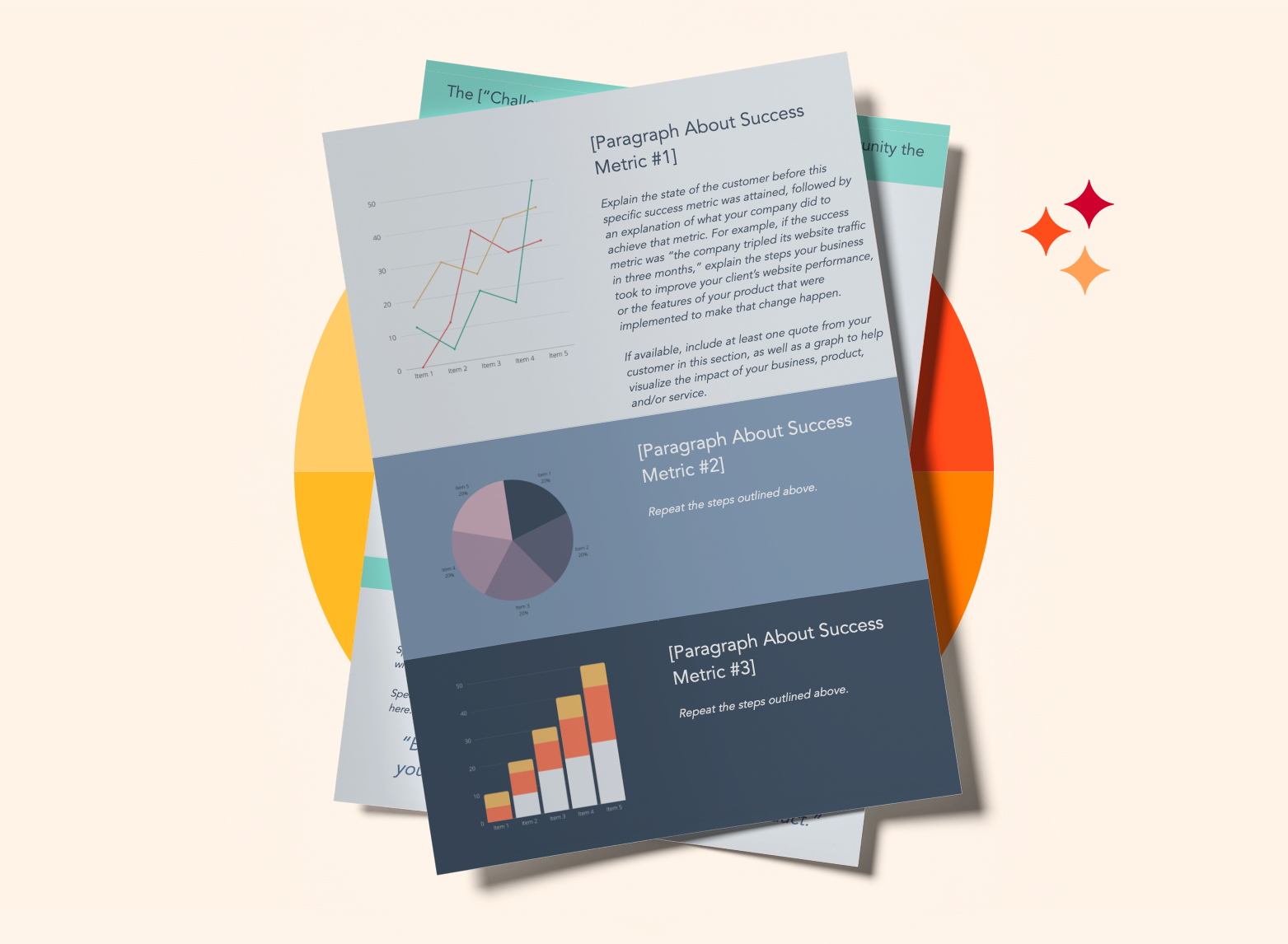
Free Case Study Templates
Showcase your company's success using these three free case study templates.
- Data-Driven Case Study Template
- Product-Specific Case Study Template
- General Case Study Template
Download Free
All fields are required.
You're all set!
Click this link to access this resource at any time.
A case study is coverage of a specific challenge a business has faced, and the solution they've chosen to solve it. Case studies can vary greatly in length and focus on several details related to the initial challenge and applied solution, and can be presented in various forms like a video, white paper, blog post, etc.
In professional settings, it‘s common for a case study to tell the story of a successful business partnership between a vendor and a client.
Perhaps the success you’re highlighting is in the number of leads your client generated, customers closed, or revenue gained. Any one of these key performance indicators (KPIs) are examples of your company's services in action.
When done correctly, these examples of your work can chronicle the positive impact your business has on existing or previous customers, helping you attract new clients.
Why write a case study?
I know, it sounds like a huge endeavor — is it really worth it?
The truth is that while case studies are a huge undertaking, they are powerful marketing tools that allow you to demonstrate the value of your product to potential customers using real-world examples.
Here are a few reasons why you should write case studies.
1. Explain complex topics or concepts.
Case studies give you the space to break down complex concepts, ideas, and strategies, showing how they can be applied in a practical way.
You can use real-world examples, like an existing client, and use their story to create a compelling narrative that demonstrates how your product solved their issue. Most importantly, it explains how those strategies can be repeated to help other customers get similar, successful results.
2. Show expertise.
Case studies are a great way to demonstrate your knowledge and expertise on a given topic or industry. This is where you get the opportunity to show off your problem-solving skills and how you’ve generated successful outcomes for clients you’ve worked with.
3. Build trust and credibility.
In addition to showing off the attributes above, case studies are an excellent way to build credibility. They’re often filled with data and thoroughly researched, which shows readers you’ve done your homework.
A robust case study instills confidence in the solutions you present because the reader has now vicariously experienced the problem — and they followed, step-by-step, what it took to solve it. These elements work together, enabling you to build trust with potential customers.
4. Create social proof.
Using existing clients that have seen success working with your brand builds social proof .
People are more likely to choose your brand if they know that others have found success working with you. Case studies do just that — put your success on display for potential customers to see.
All of these attributes play together like an orchestra to help you gain more clients. Afterward, the case study acts as a reference. You can pull quotes from customers that were featured in these studies to repurpose them in other marketing content.
How long should a case study be?
Now that you’re more acquainted with the benefits of producing a case study, let’s explore how long these documents should be.
The length of a case study will vary depending on the complexity of the project or topic discussed. However, as a general guideline, case studies typically range from 500 to 1,500 words.
Whatever length you choose, it should provide a clear understanding of the challenge, the solution you implemented, and the results achieved.
This may be easier said than done, but it‘s important to strike a balance between providing enough detail to make the case study informative and concise enough to keep the reader’s interest.
The primary goal here is to effectively communicate the key points and takeaways of the case study. It’s worth noting that this shouldn’t be a wall of text. Make it attractive to dive into by using headings, subheadings, bullet points, charts, and other graphics to break up the content and make it more scannable for readers.
I’ve also seen more and more brands incorporate video elements into case studies listed on their site for a more engaging experience, which is highly recommended given that video is currently the best performing marketing content format.
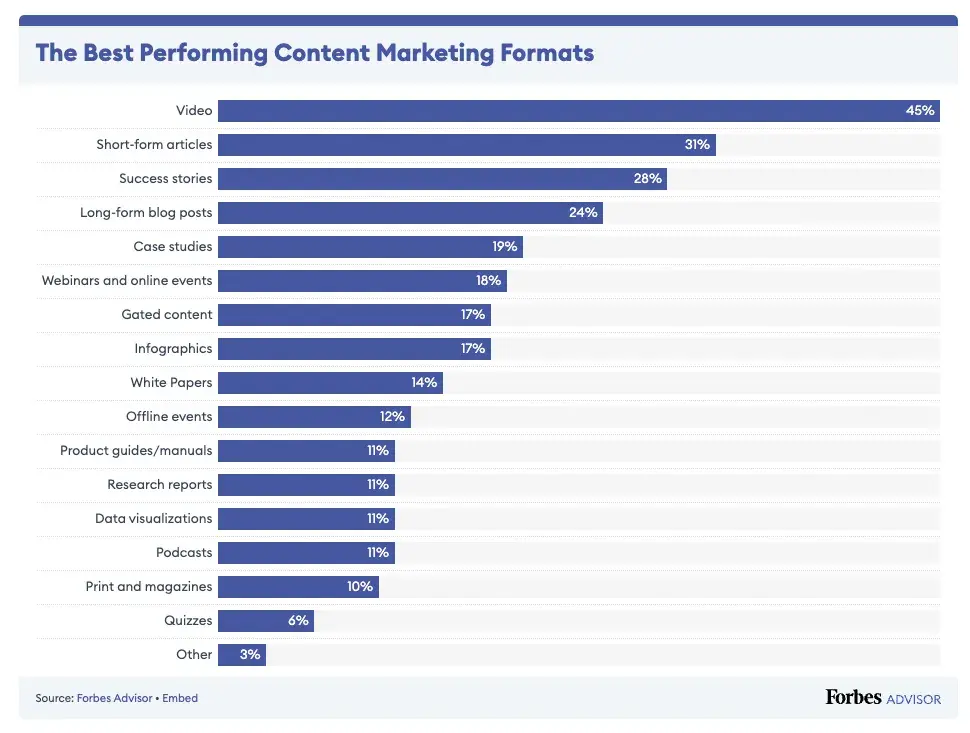

Backlinks and Website Traffic
Backlinks are a benefit sure to resonate with your subject‘s marketing team. When you publish your case study on your website, make sure that your study links back to your subject’s website. This is known as a “backlink.”
If your reader clicks the link in your case study, it takes your reader to the subject's website. Essentially, this small gesture gives them additional website traffic from visitors who have read your case study.
Additionally, a backlink from you increases your subject's page authority in the eyes of Google, which is growing in difficulty as AI infiltrates the internet.
This helps them rank more highly in search engine results. Landing higher on the SERP enables them to collect more traffic from searchers who are looking for information about your subject’s industry.
Once you know what you’re going to offer your candidate, go ahead and contact them to see if they are interested in featuring in a customer success story, with the promise of more details to follow.
6. Ensure you have all the resources you need to proceed before you get a response.
Now it’s time to prepare the resources needed for if — when! — they agree to participate. At the very least, you’ll need a case study release form and a success story letter.
Let's break those two down.
Case Study Release Form
This document can vary, depending on factors like the size of your business, the nature of your work, and what you intend to do with the case study once it is completed.
You’ll need permission to use any brand names and to share the project information publicly.
You should typically aim to include the following in your Case Study Release Form:
- A clear explanation of why you are creating this case study and how it will be used.
- A statement defining the information and potentially trademarked information you expect to be able to include about the company — things like names, logos, job titles, and pictures.
- An explanation of what you would expect from the participant beyond the completion of the case study. For example, is this customer willing to act as a reference or share feedback? Do you have permission to pass contact information along for these purposes?
- A note about compensation.
Success Story Letter
This document serves as an outline for the entire case study process so your subject better understands the entire process they would be opting into.
You'll want to be sure to define the details outlined in your Case Study Release Form within your Success Story Letter. There are many details you’ll need to think about so that you can clearly explain what the process will be like.
7. Define the process you want to follow with the client.
Before you can begin the case study, you have to have a clear outline of the case study process with your client. An example of an effective outline would include the following information.
The Acceptance
First, you‘ll need to receive internal approval from the company’s marketing team.
Once approved, the Release Form should be signed and returned to you. It's also a good time to determine a timeline that meets the needs and capabilities of both teams.
The Questionnaire
To ensure that you have a productive interview — which is one of the best ways to collect information for the case study — you'll want to ask the participant to complete a questionnaire before this conversation.
That will provide your team with the necessary foundation to organize the interview, and get the most out of it.
The Interview
Once the questionnaire is completed, someone on your team should reach out to the participant to schedule a 30- to 60-minute interview.
This should include a series of custom questions related to the customer's experience with your product or service.
The Draft Review
After the case study is composed, you'll want to send a draft to the customer, allowing an opportunity to give you feedback and edits.
The Final Approval
Once any necessary edits are completed, send a revised copy of the case study to the customer for final approval.
Once the case study goes live — on your website or elsewhere — it‘s best to contact the customer with a link to the page where the case study lives.
Don’t be afraid to ask your participants to share these links with their own networks, as it not only demonstrates your ability to deliver positive results and impressive growth, as well.
8. Download a case study email template.
You’ve gathered your resources, and soon your candidate will get to explore the exciting details of participating in your case study.
The case study release form communicates what you'll need from your chosen subject, and your success story letter outlines the process in its entirety.
Hopefully by now they’ve replied that they are interested in working with you on a customer success story. It’s time to send your case study email!
To give you an idea of what that might look like, check out this sample email.
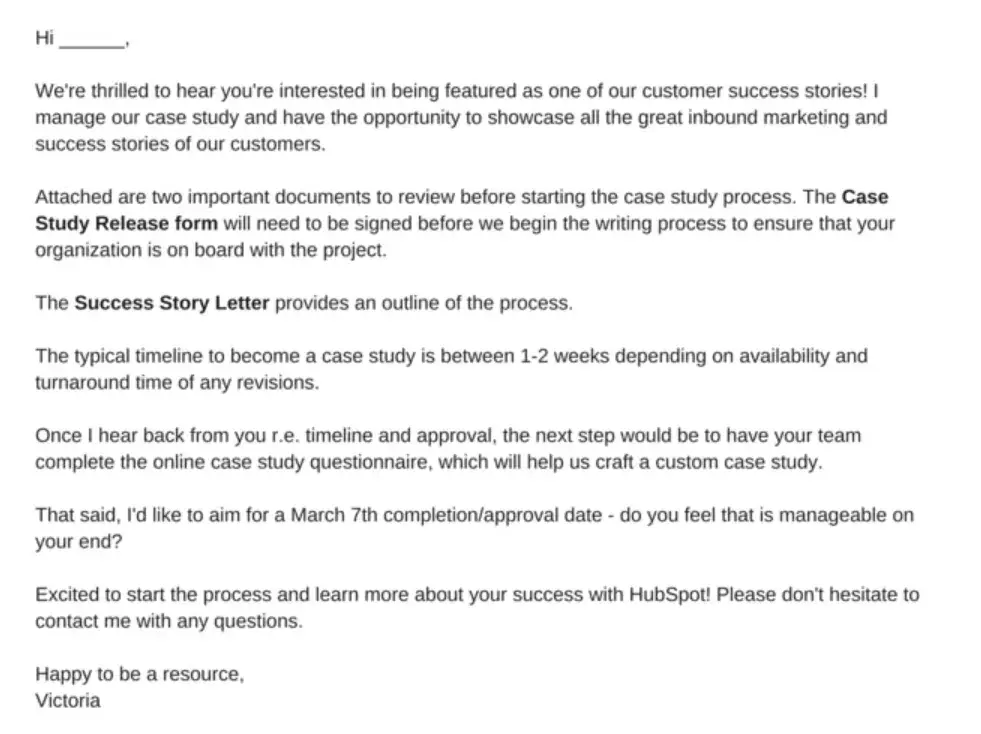
In terms of the interview structure, I recommend categorizing the questions in a way that the answers flow into six specific sections that will mirror a successful case study format. Combined, they'll allow you to gather enough information to put together a rich, comprehensive study.
Open with the customer's business.
The goal of this section is to generate a better understanding of the company's current challenges and goals, plus how they fit into the landscape of their industry. Sample questions might include:
- How long have you been in business?
- How many employees do you have?
- What are some of the objectives of your department at this time?
Cite a problem or pain point.
To tell a compelling story, you need context that helps match the customer's needs with your solution. Sample questions might include:
- What challenges and objectives led you to look for a solution?
- What might have happened if you did not identify a solution?
- Did you explore other solutions before this that did not work out? If so, what happened?
Discuss the decision process.
Exploring how the customer decided to work with you helps to guide potential customers through their own decision-making processes.
Sample questions might include:
- How did you hear about our product or service?
- Who was involved in the selection process?
- What was most important to you when evaluating your options?
Explain how a solution was implemented.
The focus here should be placed on the customer's experience during the onboarding process. Sample questions might include:
- How long did it take to get up and running?
- Did that meet your expectations?
- Who was involved in the process?
Explain how the solution works.
The goal of this section is to better understand how the customer is using your product or service. Sample questions might include:
- Is there a particular aspect of the product or service that you rely on most?
- Who is using the product or service?
End with the results.
In this section, you want to uncover impressive measurable outcomes — the more numbers, the better. Sample questions might include:
- How is the product or service helping you save time and increase productivity?
- In what ways does that enhance your competitive advantage?
- How much have you increased metrics X, Y, and Z?
It’s a smart idea to send a copy of your interview questions to your subject ahead of time so they can prepare strong answers and collect the numerical data you need from them.
10. Lay out your case study format.
When it comes time to take all of the information you‘ve collected and actually turn it into something useful, it’s easy to feel overwhelmed. I always do, but I also know that it works out in the end, so I just jump on in and work it through.
So where should you start? What should you include? What's the best way to structure it?
It‘s important to first understand that there is no one-size-fits-all when it comes to the ways you can present a case study.
They can be very visual, which you’ll see in some of the examples we've included below, and can sometimes be communicated through video or photos with a bit of accompanying text.
Here are the sections I’d suggest, and I'll cover these in more detail after #11 below:
- Title. Keep it short. Develop a succinct but interesting project name you can give the work you did with your subject.
- Subtitle. Use this copy to briefly elaborate on the accomplishment. What was done? The case study itself will explain how you got there.
- Executive Summary . A 2-4 sentence summary of the entire story. You'll want to follow it with 2-3 bullet points that display metrics showcasing success.
- About the Subject. An introduction to the person or company you served, which can be pulled from a LinkedIn Business profile or client website.
- Challenges and Objectives. A 2-3 paragraph description of the customer's challenges, before using your product or service. This section should also include the goals or objectives the customer set out to achieve.
- How Product/Service Helped. A 2-3 paragraph section that describes how your product or service provided a solution to their problem.
- Results. A 2-3 paragraph testimonial that proves how your product or service specifically benefited the person or company and helped achieve its goals. Include numbers to quantify your contributions.
- Supporting Visuals or Quotes. Pick one or two powerful quotes that you would feature at the bottom of the sections above, as well as a visual that supports the story you are telling.
- Future Plans. Everyone likes an epilogue. Comment on what's ahead for your case study subject, whether or not those plans involve you.
- Call-to-Action (CTA). Not every case study needs a CTA, but putting a passive one at the end of your case study can encourage your readers to take an action on your website after learning about the work you've done.
When laying out your case study, focus on conveying the information you've gathered in the most clear and concise way possible.
Make it easy to scan and comprehend, and be sure to provide an attractive call-to-action at the bottom — that should provide readers an opportunity to learn more about your product or service.
11. Publish and promote your case study.
Once you‘ve completed your case study, it’s time to publish and promote it.
Some case study formats have pretty obvious promotional outlets — a video case study can go on YouTube, just as an infographic case study can go on Pinterest.
But there are still other ways to publish and promote your case study. Here are a couple of ideas.
Lead Gen in a Blog Post
As stated earlier, written case studies make terrific lead-generators if you convert them into a downloadable format, like a PDF.
To generate leads from your case study, consider writing a blog post that tells an abbreviated story of your client‘s success and asking readers to fill out a form with their name and email address if they’d like to read the rest in your PDF.
Then, promote this blog post on social media, through a Facebook post or a tweet.
Published as a Page on Your Website
As a growing business, you might need to display your case study out in the open to gain the trust of your target audience.
Rather than gating it behind a landing page, publish your case study to its own page on your website, and direct people to it from your homepage with a “Case Studies” or “Testimonials” button along your homepage's top navigation bar.
The traditional case study format includes the following parts: a title and subtitle, a client profile, a summary of the customer’s challenges and objectives, an account of how your solution helped, and a description of the results. You might also want to include supporting visuals and quotes, future plans, and calls-to-action.

27 Case Study Examples Every Marketer Should See
![how to write business case study 7 Pieces of Content Your Audience Really Wants to See [New Data]](https://knowledge.hubspot.com/hubfs/contenttypes.webp)
7 Pieces of Content Your Audience Really Wants to See [New Data]

How to Market an Ebook: 21 Ways to Promote Your Content Offers
![how to write business case study How to Write a Listicle [+ Examples and Ideas]](https://www.hubspot.com/hubfs/listicle-1.jpg)
How to Write a Listicle [+ Examples and Ideas]
![how to write business case study What Is a White Paper? [FAQs]](https://53.fs1.hubspotusercontent-na1.net/hubfs/53/business%20whitepaper.jpg)
What Is a White Paper? [FAQs]

What is an Advertorial? 8 Examples to Help You Write One

How to Create Marketing Offers That Don't Fall Flat

20 Creative Ways To Repurpose Content

16 Important Ways to Use Case Studies in Your Marketing

11 Ways to Make Your Blog Post Interactive
Showcase your company's success using these free case study templates.
Marketing software that helps you drive revenue, save time and resources, and measure and optimize your investments — all on one easy-to-use platform
- eSignatures
- Product updates
- Document templates
How to write a business case study: your complete guide
Hanna Stechenko Manager, SEO Management
- Copy Link Link copied
Business case studies are powerful tools for marketing, teaching, and training. They help to create valuable learning experiences that can be shared with others.
A well-written business case study can also generate leads, increase customer loyalty, and boost sales.
But writing an effective and compelling case study can be easier said than done.
Great case studies aren’t something that you can write by yourself.
You’ll need help from existing clients who are willing to talk about their problems publicly, and you’ll need to safeguard their reputation while you tell their story.
It’s tricky.
In this article, we’ll take a closer look at how to write a business case study, including best practices, case study templates, real examples, and more.
Let’s jump in.
What is a business case study?
A business case study is an in-depth look at a specific company or organization that examines how a business solved a problem, achieved success, or faced failure.
Case studies are often used by businesses to demonstrate the effectiveness of their strategies and solutions.
They can also serve as inspiration for other organizations that may be considering similar approaches.
The idea is simple: Stakeholders evaluating a product may be able to see the value of that product by learning how other companies have tried and succeeded with it.
For that reason, 42% of marketers still list case studies as a top media format used to generate leads and sales.
Strong case studies are often based on interviews with actual customers to highlight the effectiveness of a specific feature, explain a certain use case, or emphasize benefits or results of note.
Done correctly, a case study combines customer testimonials, process information, and usage data to tell a unique story about how a product or service helped a company succeed.
That’s why case studies are sometimes known as customer success stories.
What makes a strong case study?
Before we jump into the details of how to make a great case study, let’s take a closer look at what a strong case study actually looks like.
To create a great case study, you’ll need each of the following:
- Clear, compelling storylines. A good case study should include a clear story line that conveys the problem, solution, and the impact of the solution.
- A strong presentation of data. Demonstrate how your product or service has made an impact on the customer’s business with documented facts and figures.
- Credible client testimonials. Include feedback from real clients and users about how your product or service solved their issue. With permission, use a person’s real name and job title and personal experience to add credibility to your case study.
- Streamlined visuals. Graphics, photos, charts and/or videos can help illustrate results in an engaging and easy to understand way.
- Call to action. Always include a link to more information or a contact form at the end of your case study.
While all of these components are essential to great case studies, they aren’t always easy to acquire. Be prepared to dig for information and work closely with customers to build compelling content.
Why use case studies at all?
Great case studies can take some time to create.
Considering budgets and deadlines, why should you even bother using them when you could create more landing pages, buy more ads, or write more blog posts?
It’s a fair point to consider.
Case studies come with a unique set of benefits for your marketing strategy that other forms of content simply can’t fill.
1. They can last a long time
A single case study can be used as sales and marketing collateral as long as the feature products or services are still relevant.
If your products have a long lifespan, the same piece of content may be useful for months or years.
2. They’re relatively inexpensive
Case studies are relatively inexpensive to produce compared to other forms of marketing, such as white papers, e-books, and long-form blog content.
3. They drastically boost your credibility
Done correctly, case studies demonstrate the effectiveness of your products and services from the perspective of customers who have benefited directly from using them.
In a sense, case studies represent your products and services through the eyes of customers who have already taken the proverbial leap of faith.
When speaking to prospects and leads who aren’t fully bought in, they can minimize risk and offer assurances in a way that no other piece of sales and marketing collateral can match.
With all of that preliminary information out of the way, let’s take a closer look at how to actually build an effective case study.
Before you start: Understanding stakes and obstacles
The strongest case studies are usually created in collaboration between two companies: Your organization and that of a current or former customer with whom you have a good relationship.
At a high level, the process is straightforward:
- Question creation . Your team compiles a list of interview questions designed to tell a compelling story for new, prospective customers.
- Interview. Your team interviews a representative or stakeholder from the customer-partner organization.
- Draft. After the interview is complete, your team transforms the interview into a complete narrative.
- Feedback round. The customer-partner reviews the draft and provides feedback and input.
- Final draft. Your team makes corrections based on that feedback and resubmits for final approval.
- Final approval. The customer-partner approves the draft.
- Publish. Your team creates marketing collateral and publishes or shares the case study.
Simple, right?
Unfortunately, the process is rarely this smooth.
There are several outlying factors that can stop your case in its tracks or prevent it from ever seeing the light of day.
Here are some factors that you’ll need to consider before you start the case study process.
1. Relationship
Potential interview targets are more likely to agree to an interview if they have a strong relationship with someone on your team, like an account manager or a longtime sales rep.
Without a way to get your foot in the door, your interview request may be politely declined.
2. Availability
People are busy.
It’s not uncommon for the interval between reviews and approvals to take weeks at a time.
Because case study drafts need to be approved by both parties, expect delays while your drafts are circulated through your partner organizations.
3. Branding
Even if your product or service helped an organization overcome a huge obstacle, they may not want to talk about that weakness in a public forum.
Many companies are very cautious about anything that portrays their brand in an unfavorable light.
4. Legality
If your customer-partner doesn’t like what you’ve written, they may simply forbid you to use their name, logos, or data as part of your case study.
Moving forward without their permission could cause legal issues and damage customer relationships.
5. Approval
Sometimes, it’s impossible to get final approvals from the appropriate individuals in the customer-partner organization.
If HR or legal needs to sign off on the final product before it can be officially released, it could take weeks or months before that final approval comes through.
Above all else, remember: The customer-partner that agrees to help you create a case study is doing you a favor.
Most of the time, the customer-partner receives no benefit from the time and effort spent creating this piece.
They can’t use it to sell their own services, and they may reveal information and data that demonstrates a weakness in their management or internal process.
Keep that information in mind as you select your customer partners.
Be sure to treat these partners with care and respect, as a bad case study experience can damage a healthy customer relationship.
Step 1: Planning and prep
Business case studies will usually fall under the domain of your marketing team, but you’ll need to be specific when assigning project tasks and responsibilities.
Here’s what you need in order to create a case study:
- Internal project stakeholder. This individual oversees the project internally. They assign tasks, handle outreach, and oversee the production and delivery of the case study.
- External project stakeholder. The individual at the customer organization who agrees to help. This person may or may not be the individual who is interviewed by your organization.
- Interviewer. The individual who conducts the interview.
- Writer. The individual who writes the case study.
- Project manager. The individual who manages the case study project and ensures that deadlines are met.
- Internal editor or approver. The individual who reviews the case study and provides feedback or final approvals.
- External editor or approver. The individual at the customer organization who reviews the case study and provides feedback or final approvals.
- Designer. The individual who formats the case study, provides data-based graphics and illustration, or produces the final product file (typically a PDF or web page) with the case study and all relevant content.
Sometimes, these roles are combined.
The internal project stakeholder may also manage the product and provide editorial feedback after the case study is written.
Or, if you’re working with a freelancer for this process, they may conduct the interview, write the draft, and furnish a final design.
Next, consider your goals:
- Why are you writing this case study? Do you have a specific goal, such as boosting lead generation or improving customer lifetime value (CLV)?
- If your case study is angled to grow business with existing customers, you may select different features from case studies meant to introduce prospective customers to your products.
- This could include add-on services or premium product features.
- Do you have any new products, services or updates you’d like to share with the world?
- Do you have a new positioning strategy?
After you’ve defined your objectives, it’s time to start considering who you might want to interview.
1. Make your list specific
Include the company name, any relevant notes and the name of the intended stakeholders to be interviewed.
2. Only include notable candidates
Make sure that your interview targets have experienced substantial or notable results with your product.
Look for clients who have experienced exceptional and transformative outcomes while using your product or service.
3. Consider existing relationships
Look for clients that already have a strong working relationship with you.
If they regularly work with an account manager or are in constant contact with specific team members, consider bringing those individuals into the conversation early.
Once you have your targets, reach out, explain your project, and see if the customer is interested in participating.
When you ask for an interview, be sure to mention the following details:
- The purpose of the case study and what you’re ultimately trying to accomplish.
- A brief overview of the case study process (including the interview process and what happens next).
- Timeframes and estimated deadlines.
- A general idea of the kinds of questions they may be asked.
- Explain scenarios for how and where the case study may be used (you’ll need their permission to share it with your audiences).
- Thank them for their time.
If they agree, start scheduling your timeline.
Work backwards from the date you’d like to publish, then build in dates for reviews and edits. Also create a flexible internal deadline for securing a client interview.
Since you’ll need to align your schedule with that of your interviewee, pinpointing an actual interview date can take some time.
Step 2: The interview process
As we mentioned above: Most of the time, the customer-partner that agrees to help you with your case study receives no major benefit from the project.
It helps you, but it doesn’t usually help them.
With that in mind, your goal during the interview process is to make things as easy, streamlined, and stress-free as possible.
One major step that you can take to calm nerves and prevent misunderstandings is to send an interview questionnaire prior to your interview.
This will help your customer-partner understand your main objectives and prepare their responses in advance.
Here are a few sample questions you might use:
- How many team members use our product/service? Which departments?
- What were your challenges before using our product/service/process?
- What made you leave your previous solution for our product?
- How do you use our product/service/process?
- What features or tools have been the most helpful for your business?
- If you asked us for help, how did we provide you with what you need? We’d like to understand this from your perspective.
- How have you benefited from our offering–and what have been your greatest results to date? Please provide specific metrics, if possible.
- What surprised you most about using our product/service/process?
- How have your customers or clients benefited from your use of our products or services?
- Is there anything else you would like us to know?
When you sit down to interview the client, it’s easiest to follow the interview questions that you sent over and simply record their responses.
However, don’t just stick to the script during the actual interview . Listen and actively engage with your interviewee.
Ask follow-up questions. Clarify details. Explore the answers in real time with your interviewee.
Use the opportunity to dig deeper and gather all the information you need to tell the right story to your prospects and leads.
You might also use a tool like Otter.ai to record and capture the transcript at the same time, but be sure to have your customer-partner sign a recording permission release if you intend to use sound bytes from that recording as part of your final case study.
Step 3: Writing your business case study
Ideally, the interview is the last piece of information you need before writing your case study.
All of the background information and preliminary work should be done as part of the interview preparation.
When you finish speaking with the customer-partner, it’s time to consolidate your notes and write the draft.
Before you begin, take a moment to review your overall objectives and the story that you want to tell. From there, select a format for your case study and start the draft.
Regardless of the modules, headings, or illustrations that you use, the case study should cover what life was like before the customer started using your product or service and what happened after they adopted those products/services into their workflow.
Sample case study outline
1. introduction.
A brief description of the case study’s contents (bullet point key metrics and successes).
2. Company overview
A brief description of the featured company — what they do, who their customers are, what they sell, etc. Include brief background/context as to how they use your product, service or process.
3. Problem / Challenge
Describe the business problem or opportunity that your customer was facing before they started using your product or service.
Include strong quotes and fully illustrate why the issue was a problem that needed to be solved.
4. Solution
Explain how the customer used your product to solve their problem.
Share their decision-making process, how they arrived at your solution, what convinced them to purchase, and how they implemented that solution internally.
Share benefits and features that stood out to them. Reinforce these details with quotes from your interview.
Summarize the outcome from the customer’s implementation of your product, service, or process.
Recap their wins, as well as the major improvements that they have seen over both the short and long term.
Add data and metrics, where relevant. Include quotes about how the current solution empowers the company and solves their problems.
6. About us
Share a brief explanation of your company and the products or services you provide.
7. Call-to-action (CTA)
Add a call to action with the appropriate contact information (or a contact button, if this is a web-based case study) so that users can get in touch for additional information after reading the case study.
When it’s time to start writing, gather all relevant information and relevant links (white papers, other case studies, sales and spec sheets, etc.) to make sure you have access to the full scope of information related to the products and services mentioned in your case study.
Your goal isn’t to overload the reader by explaining everything. Instead, focus on creating a benefits-driven story around the features that your products and services provide.
Use data and details to provide precise information at key points.
It’s likely that you will need to bridge the information gap between your interviewee and your target audience.
Since your clients know you understand your product or service, they’re likely to answer your questions in broader terms.
However, your readers will not be as familiar with your organization and may only have limited experience with what you sell.
Instead, you’ll need to provide context as you write. If your business has buyer personas or ideal customer profiles (ICP), it’s a great idea to keep those on hand.
It’s also important to reserve enough writing time to get creative. Thoughtfully work your way through your materials to come up with the type of angle that will make your case study worthwhile.
Best practices
- Start with an attention-grabbing, relevant headline.
- Avoid lengthy explanations unless you’re working on a more complex case study.
- If you’re writing a business case study that’s complicated because of the subject matter or necessary background information, consider starting the content with an executive summary to improve readability.
- Only include a table of contents for lengthier case studies.
- Write in the third person.
- Avoid alienating your readers by assuming they’ll understand technical details. Skip the jargon and explain every acronym to hold their attention the entire way.
- A good business case study is a story. Make sure it has a strong beginning, middle, and end. A conversational tone often works best.
- Keep it focused. Don’t highlight a million wins for a single case study. Pick one or two combinations of challenges and solutions instead. If you include more, you might dilute your message or bore your readers.
- Always include direct quotes for an added dose of personality, energy, and human connection.
- Include stats or metrics whenever possible, such as increased revenue, the number of new customers gained, or a measurable boost in traffic.
- If you’re in a very visual industry like graphic design, advertising, fashion, or interior design, include on-brand images where relevant.
- Standard case study length: Roughly 500-1000 words.
- Long-form case study: Roughly 1500-2000 words.
- Make your customer-partner the hero. While your products and services are key to customer success, they are ultimately there to aid the customer in the important work that they do.
Revise and review
Once you’ve completed your case study draft, take a few minutes to re-read everything and ensure that the draft tells the right story.
- Double-check that all facts and figures are correct.
- Set it aside for a time and get some distance. Return to the draft with a fresh perspective.
- Pass it to your colleagues, including internal stakeholders and approvers, for feedback.
- Provide enough details and context so that readers can see customer benefits and how your solution can help them succeed.
Seek client approval
When you’re satisfied with your case study, it’s time to send a copy of the draft to your client for their review and approval.
This is an important step in ensuring maximum transparency and visibility.
Your customer partner should know exactly what you plan to share and have enough time to share it with key stakeholders from their marketing and/or legal department.
It is highly likely that your customer-partner will request changes.
Some changes may be simple (such as clarifying job roles), but others may be more drastic.
Your customer partner may request that you remember sensitive data and details or phrase issues in a more favorable light.
Most organizations seek to avoid bad press and prefer not to point out key weaknesses in their internal processes and strategies.
Be prepared to soften your language or advocate to keep key data points in place.
This is often one of the most critical parts of the case study process. Proceed with caution and choose your battles wisely.
While you can push back on suggested changes, remember that your customer-partner can rescind the use of their name and information in your case study.
Though you can choose to publish anyway (with names and titles omitted), your case study would be far less influential as a result.
Regardless of the potential gains from a case study, it’s not worth poisoning a relationship with a customer that actively uses and promotes your product.
Step 4: Marketing your case study
When you have the finished product, it’s time to share and promote your case study. Think about using these channels:
- A dedicated landing page.
- The resources section of your website.
- Your company blog.
- One or a series of marketing emails.
- Social media.
- Custom infographic.
Requiring readers to fill out a short online form to get the download may allow sales and marketing teams to connect with potential leads.
If you do go the gated route, be sure the conditions of opting in are crystal clear. And feature a couple of non-gated case studies on your site for everyone who’d prefer to skip the forms.
Regardless of how you market your case study, don’t forget about your sales team!
Sales reps will get a lot of use out of your case studies.
They can feature them as links in their email signatures and include them in sales emails and proposals for new clients and potential customers.
Ready to get started? Try out this case study presentation template .
Good case study examples (and why they work)
If you’re struggling with case studies, you can find plenty of great examples around the internet.
Start reading well-executed case studies to learn more about what makes them work.
Below, you’ll find a selection of three very different but successful case studies.
PandaDoc case study
Intro : Before diving into the body of the case study, we briefly introduced the company, TPD, and highlighted three major metrics for a promising start.
The problem: We quickly engaged readers with our conversational tone. We also invited them to walk in TPD’s shoes through empathetic language and relatable context.
Challenges, solutions, and results: We took readers on a storytelling journey to help our case study flow. We gave them enough information to understand the “why”, but never bogged them down with unnecessary details. We were also sure to include supporting quotes and specific, measurable results in these critical sections.
Pull quote: We reserved the very best quote as the only pull quote, ensuring it would receive the attention it deserves.
Format: Finally, every time we mentioned a new company, we gave it a hyperlink to help readers save time.
Trello case study
Unicef + trello: helping others when they need it most.
Facts and figures : Trello opens the case study with great at-a-glance information, sharing insights into UNICEF as an organization and their relationship with Trello products.
Challenges, solutions, and results: This case study takes readers through a detailed narrative, providing statistics and metrics whenever possible. Readers are immersed into the story of exactly how UNICEF used Trello to help thousands of people during a natural disaster, offering enough detail to spark use case inspiration for other Trello users.
Photos: Trello included photos of actual UNICEF employees working remotely around the globe. The pictures gave the case study a personal feel, which could help readers better identify with the story.
Readers are reminded of the unique challenges of working together while apart to start considering how Trello might be able to help them find the solutions they need. Remember, the best case studies are relatable to all of your prospects!
Format: Its structure makes this longer case study easy to read. Sections of text are kept short while bullet points and pull quotes provide visual breaks.
Finally, hyperlinks to organizations’ websites open in separate tabs to help prevent losing case study readers along the way.
Stripe case study
Simplepractice launches automatic payments offering for clinicians with stripe.
Intro: In just two sentences, Stripe successfully manages to explain what SimplePractice is, what they offer, who they serve, how they serve them, and the benefits those clients gain.
While it’s not necessary to be this brief, readers will be more likely to read your entire intro if it’s on the shorter side.
Sidebar : The sidebar draws eyes to keep reading with two impressive metrics and a brightly-hued CTA button to “contact sales”.
Challenge and solution: These sections read like a story, with each sentence enticing the reader to continue to the next. It’s also great that a quote from SimplePractice’s COO is used to add context, emphasizing the gravity of their challenge.
Results: Stripe gives a lot of detail here for a strong close to the case study. After explaining how their offering brought ease to SimplePractice’s business, they went on to share detailed specifics on what made things easier and in what ways.
They also explained how their offering improved the businesses of SimplePractice’s clients. It’s highly persuasive for readers to understand they have the opportunity to not only benefit their own companies but also those of their clients.
Pull quote: The case study ends with a strong pull quote in a can’t-miss-it color.
Format: Stripe has a great case study format.
Wrapping up
The truth is: No matter how much you talk up your product, you’re a biased participant in any conversation. You have an ulterior motive, and that makes any direct claims you make about your product or service questionable.
Why? Because you want to sell your product!
Case studies offer an alternative way to soften your messaging by allowing prospects and potential buyers to hear from the people who use your products in real-world, everyday situations.
By placing your customers and their experiences at the front of your marketing, you can use trust and relatability to bridge a gap in a way that numbers and data just can’t provide.
Your customers already have great stories about how your solutions have transformed the work that they do.
Help them speak and share those stories with the people who need to hear them most with a case study.
Good luck? Be sure to check out other marketing tips and tricks on the PandaDoc blog .
Frequently asked questions
What is the best business case study format.
The best business case study format depends on the nature of the results and what you’re trying to achieve. You can figure that out by carefully reviewing your customer success stories and interviews.
- What stands out the most?
- What are you trying to achieve?
- How can you use your layout to guide readers through your story?
- What is your industry or what is the industry of your featured client?
Pro tip : Some interviews are more quotable than others. If you have too many great quotes to include them in your featured sections, consider adding a few pull quotes to your layout.
How do I create a business case study outline?
To create a business case study outline, list all of your featured sections and use bullet points to note subsections and what should be covered.
Most case studies feature the following sections:
- Introduction
- Brief Description of Customer’s Business
- Problem/Challenge/Opportunity
- Results/Conclusion
- About Us / Boilerplate
- Call-to-Action (CTA).
But outlines aren’t just for traditional case studies. Use outlines to guide your infographic and video versions too.
What are some case study best practices?
Best practices for writing case studies include:
- Crafting short, easy-to-digest sections.
- Weaving in a narrative for engaging storytelling.
- Starting with an engaging headline.
- Writing in layman’s terms.
- Explaining any necessary acronyms.
- Including any supporting metrics or statistics.
- Using direct quotes to bring your customer’s story to life.
Also, be sure to get the approval of your client and their marketing team after you’ve had time to review your first draft and fact-check all information.
Where can I find a good case study design template?
You can find a good case study design template on PandaDoc.
Our company’s expertise is spot-on and the case study templates are free. Also, don’t be afraid to branch out. Let’s say you have a big following on YouTube or Spotify.
You might want to create a video or podcast version of your case study for readers who prefer audiovisual information.
Or, you may want to add multimedia content to your case study, such as a video insert or or audio clip.
PandaDoc is not a law firm, or a substitute for an attorney or law firm. This page is not intended to and does not provide legal advice. Should you have legal questions on the validity of e-signatures or digital signatures and the enforceability thereof, please consult with an attorney or law firm. Use of PandaDocs services are governed by our Terms of Use and Privacy Policy.
Originally published October 27, 2022, updated March 30, 2023
Related articles

Proposals 13 min

Proposals 14 min

Proposals 12 min
Streamline your document workflow & close deals faster
Get personalized 1:1 demo with our product specialist.
- Tailored to your needs
- Answers all your questions
- No commitment to buy
- Fill out the form
- Book a time slot
- Attend a demo
By submitting this form, I agree that the Terms of Service and Privacy Notice will govern the use of services I receive and personal data I provide respectively.

IMAGES
VIDEO
COMMENTS
A business case is a written document (often a PowerPoint presentation) that articulates the value of a specific business project or investment. It presents the rationale for the project, including the benefits, costs, risks, and impact.
Three expert HBS case writers share their insights on how to write a great business case study that will inspire passionate classroom discussion and transmit key educational concepts.
This guide will show you how to write an effective case study and provide real-world examples and templates that will keep readers engaged and support your business. In this article, you’ll learn: What is a case study?
To help you arm your prospects with information they can trust, I've put together a step-by-step guide on how to create effective case studies for your business with free case study templates to help you create your own.
1. Planning and prep. 2. The interview process. 3. Writing your business case study. 4. Marketing your case study. Schedule a demo. Business case studies are powerful tools for marketing, teaching, and training. They help to create valuable learning experiences that can be shared with others.
How to write a case study. Understanding how to write a case study is an invaluable skill. You'll need to embrace decision-making – from deciding which customers to feature to designing the best format to make them as engaging as possible. This can feel overwhelming in a hurry, so let's break it down. Step 1: Reach out to the target persona.